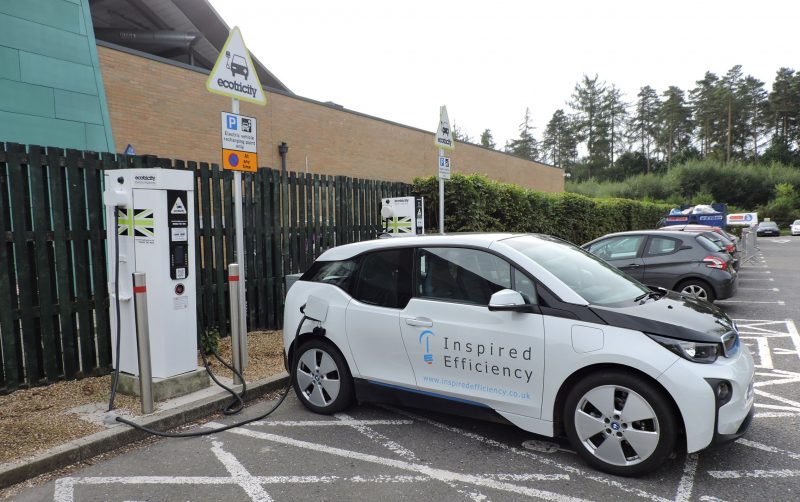Two years with an Electric Vehicle
November 2014 brought in a new era in Inspired Efficiency’s drive to demonstrate how it is at the cutting edge of efficiency, not only in the services it offers to its clients but also the way in which it conducts its own business. It was in this month that IE went over to driving on electric with the arrival of the BMW i3 Electric Vehicle.

IE is about as far away as you can get from your stereo-typical BMW driver, having previously driven two Smart cars and finding greater pleasure in efficiency than image! The i3 was chosen as it was a comfortable car in which all the family could fit in and had the range extender (a small petrol generator which can trickle charge the battery if it’s getting very low so you don’t get stuck anywhere). Perhaps this choice shows the greatest concern for anyone thinking about an Electric Vehicle .. the range anxiety … aka ‘will I run out of charge before I get home?’.
So almost two years and over 30,000 miles later what’s the verdict?
Well, it’s the best, most comfortable, relaxing and best performance car I have ever driven. If you think Electric Vehicles are the next generation of milk float, think again. It’s quick, seriously and effortlessly quick. No gears to have to work through just 100% torque to the rear wheels by the electric motor means that there is no hanging around at the lights. But more than that, the lack of a noisy engine with all its vibrations, any gear box or transmission system and energy recovery on its breaks makes it smooth, quiet and easy; ideal for comfort. If you haven’t driven an Electric Vehicle then please don’t have any ideas about what they will be like to drive until you have!
80 miles is a really long way. It doesn’t sound like it but that distance gets you to many places, and if you can find a charger there, then you can go from IE’s office in the Cotswolds to London and back without a problem. A recent ‘software update’ on the car seems to have increased its range to about 90 miles, and the next generation of Electric Vehicles are now already providing 120 to 200-mile ranges. I have used the range extended a number of times but far far less than I thought I would. In total, over almost two years I have probably put less than £40 of petrol in the range extender. Which got me thinking, how long would the range need to be before I would be comfortable in not having a range extender at all? For me, living in the rural Cotswolds and doing 15,000 to 20,000 miles a year, if my next Electric Vehicle had a range of 140 miles I would be very relaxed about not having a range extender…..oh, that’s about where the industry is currently!
The current charging infrastructure is quite good but needs some rationalisation of suppliers. There are three ways to charge an Electric Vehicle; the charging suppliers would call then standard, fast and rapid but might be better described as slow, OK and impressively quick!
The slow is a 13amp plug socket into the wall, I have that facility, I’ve used it about three times, and it’s not really worth it. It would take about 8 hours to get a charge so it’s there for those times when you are staying overnight at a friends house and can plug into a garage, but that’s about it.
The most used option is the 32amp charger. This is what I have on the side of my house, and what’s on all the little posts and wall mounted boxes that are in public car parks and the like. From this, I can get an 80% charge in just under two hours and fully charge in about two and a half. If every new building, public car park, and train station had a few of these, it would be brilliant. They aren’t even expensive to install. There are enough in most town centres to mean I can charge during meetings etc. but not enough at train stations or outside towns and cities to be ideal. I did have a thought the other day…if every church in the country had a 32 amp charging point outside it then you would never be far away and could find one easily by looking up and spotting the nearest tower or spire! In the meantime, I would be lost without ZapMap on my phone which shows me where every charging point is in the country, but I wish they would improve the postcode search of their online map and actually drop a pin on the search address!
Then there are the rapid chargers. These are the big white boxes that you will see at motorway service stations and in 20 mins I have an 80% charge. So a cup of tea, a quick check of the emails and I’m on my way again. Every motorway service station has one, and a huge thank you to Ecotricity for putting this in place. I would not be able to live with an Electric Vehicle without these, and they are brilliant. They were getting a bit over-used as they were entirely free. They have now bought in a small fee for their use which means the availability is much better. What’s even better is that they still provide the charges for free for Ecotricity customers of which I have been one for many years. Milton Keynes is also lovely to drive through as it has loads and loads of rapid chargers and should be the model for other towns and cities to follow. The only issue with the rapid chargers is there are about three different types of connector depending on the make of your vehicle so you have to find the right one for your car – a lot now have all three on them but come on car industry, standardise, please!
To access the chargers, you tend to need a contactless card for the charging company that operates it. The biggest network is Polar/ChargeMaster and the most useful being Ecotricity, but there are about four or five others (Source, Podpoint, C2C, SSE, etc.) You need a separate card for each of these, perhaps that’s why BMW usefully designed in a compartment in the arm rest in which half a dozen access cards reside. It would make life so much easier if there was one national system to access all chargers.
So you can have an Electric Vehicle, live out in the sticks, do 20,000 miles a year of good, fun, high-quality motoring, pay no road tax, have very low ‘fuel’ costs and not get stuck …. I fail to see how this will not be the future.
Oh, just don’t buy into any servicing packages, almost two years in and it’s not needed a service yet, I guess there is not much to service!
Latest News & Views.
2022 Autumn Statement
The 2022 Autumn statement, delivered today, finally recognises energy efficiency as being a key requirement to address the current challenger…
Feast and Famine
Schools, and the rest of the public sector, in England are currently left with no available funding to pay for energy efficiency and carbon reduction works
A Green Budget?
The March 2021 budget, titled “Protecting the Jobs and Livelihoods of the British People” was a major opportunity for the Chancellor to kick start the green recovery following COVID
Public Sector Decarbonisation Scheme Round 2 (or is it?)
Phase 2 of the Public Sector Decarbonisation Scheme has been announced on 17th March 2020 with applications open for submission on 7th April
